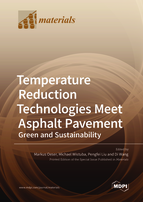Temperature Reduction Technologies Meet Asphalt Pavement: Green and Sustainability
A special issue of Materials (ISSN 1996-1944). This special issue belongs to the section "Construction and Building Materials".
Deadline for manuscript submissions: closed (20 August 2022) | Viewed by 22980
Special Issue Editors
Interests: application of numerical methods on pavement engineering; construction of constitutive models of pavement materials; design method of high-performance permeable pavement structure; development of polyurethane material; characterization of mechanical behavior of asphalt mixture at multiscale
Interests: sustainability of road infrastructures; the fundamental mechanisms that control behavior and durability of asphalt materials and pavement systems; technical testing to address performance properties; composition of asphalt mixtures considering various additives and re-using reclaimed asphalt; design of highway and airport pavements; development of road management concepts
Special Issues, Collections and Topics in MDPI journals
Interests: asphalt pavement design; application of numerical methods on pavement engineering; bearing capacity of asphalt pavement; meso-model of asphalt pavement considering its multiphase
Special Issues, Collections and Topics in MDPI journals
Interests: asphalt pavement; low-temperature properties of bituminous materials; sustainability of road infrastructures; fatigue properties of asphalt mixtures; solid recycling materials used in asphalt pavement
Special Issues, Collections and Topics in MDPI journals
Special Issue Information
Dear Colleagues,
Temperature reduction technologies have been used worldwide in the last two decades in asphalt pavement engineering. The aim of these technologies is to use lower temperature throughout production processes while without losing the performance properties of asphalt materials. Currently, different levels of temperature reduction technologies, includes warm mix asphalt, half-warm mix asphalt and cold mix asphalt, can be accomplished using varieties of organic/chemical additives and foaming/emulsion techniques. Significant economic and environmental benefits can be achieved, including but not restricted to energy, greenhouse gas and fume emissions reduction, and increased field workability. However, there are still several knowledge gaps to overcome. For example, the incomplete drying of aggregates caused by the lower production temperature may ultimately lead to serious rutting and moisture damage. These limitations hinder the mega-scale application of temperature reduction technologies in asphalt pavement constructions.
This Special Issue covers various subjects related to advanced temperature reduction technologies in bituminous materials. Research on the investigation and application of varieties of technologies is welcome. The assessment of influence on the in-service performance, economy, environment effect, and life-cycle assessment are all invited. Literature reviews are also highly appreciated.
Prof. Dr. Markus Oeser
Prof. Dr. Michael Wistuba
Dr. Pengfei Liu
Dr. Di Wang
Guest Editors
Manuscript Submission Information
Manuscripts should be submitted online at www.mdpi.com by registering and logging in to this website. Once you are registered, click here to go to the submission form. Manuscripts can be submitted until the deadline. All submissions that pass pre-check are peer-reviewed. Accepted papers will be published continuously in the journal (as soon as accepted) and will be listed together on the special issue website. Research articles, review articles as well as short communications are invited. For planned papers, a title and short abstract (about 100 words) can be sent to the Editorial Office for announcement on this website.
Submitted manuscripts should not have been published previously, nor be under consideration for publication elsewhere (except conference proceedings papers). All manuscripts are thoroughly refereed through a single-blind peer-review process. A guide for authors and other relevant information for submission of manuscripts is available on the Instructions for Authors page. Materials is an international peer-reviewed open access semimonthly journal published by MDPI.
Please visit the Instructions for Authors page before submitting a manuscript. The Article Processing Charge (APC) for publication in this open access journal is 2600 CHF (Swiss Francs). Submitted papers should be well formatted and use good English. Authors may use MDPI's English editing service prior to publication or during author revisions.
Keywords
- asphalt pavement
- green materials
- temperature reduction technology
- half-warm mix asphalt
- warm mix asphalt
- cold mix asphalt
- performance properties
- greenhouse gas and fume emission
- life-cycle assessment










